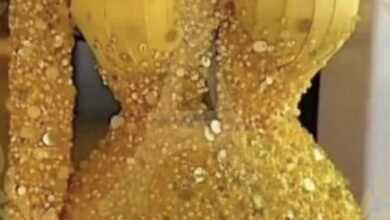As far back as the Stone Age, men and women wore crystal jewelry and talismans. They had protective as well as decorative function, mainly believed to be guarding their wearer against harm.
Nowadays, crystals carry the same power and jewellery can be selected not just on the basis of outward attraction. Wearing crystals or simply having them in close proximity can boost your energy (Orange Carnilian), clean your space (Amber) and attract wealth (Citrine). Carefully positioned, crystals can change your life.
The Crystal Bible by Judy Hall
Crystal power has changed Virgilia’s life. Five years ago, she went through a divorce after more than 10 years of marriage. She went on a trip to the desert and there, discovered her new path in life. She studied crystals. Virgilia, now 40, has a shop on a Nile cruise boat between Luxor and Aswan.
Virgilia sits there quietly, in a corner of her shop, working on a piece of jewellery and is not bothered by the customers and tourists. She rarely interferes in a customer’s choice and doesn’t have this ‘can I help you?’ attitude.
“Stones have powerful healing energy. You are usually attracted to the stones your body needs. I like the customers to interact with the energy of the stones and decide for themselves. When they make up their minds, I talk to them about the powers of the stones they have chosen and print them some material as well,” says Virgilia.
Layal Rustom is a jeweller herself and one of Virgilia’s customers. She chooses a necklace of silver and citrine. “Citrine carries the power of the sun; it acts as an energizer and enhances creativity. It is a healing stone and it also absorbs negative energy,” comments Virgilia on Layal’s choice of the yellow stone.
Layal, 23, entered the profession by mere chance. “I was looking for specific accessories made with certain crystals; when I couldn’t find them, I decided to make them myself. I went to the market and started buying crystals. I was fascinated by the colours and the texture of different stones, so I bought a lot. I went home and started trying different patterns,” says Layal.
Layal’s designs are simple and unique; they come purely out of her imagination. She has only two years of experience in designing accessories and a very fresh eye. “I started by doing very simple patterns using one stone and one colour, then I started combining different colours, then different stones and different shapes. I learned both by experience and by asking people in the market. They are very resourceful. They gave me advice on different materials, strings and so on,” says Layal, who works as a book store assistant manager.
A lot of Layal’s information comes from books on jewelry design. Layal also believes in the energy of the crystals. “Each stone has a shape and a feel, when I work on a piece, I communicate how I feel to the stone, and both my energy and the stone are felt by customers. And they appreciate this,” said Layal who doesn’t have a store, but displays in her mother’s antique gallery in Heliopolis and in many open days. Her pieces run out very quickly because they are reasonably priced, simple and feminine.
Like Layal, Mousha came into the profession completely by chance. The 28-year-old is the newest entry into the world of Egyptian jewelry designers specialized in silver and semi-precious stones. The daughter of the renowned singer Ali El Haggar and actress Moushira Ismael, she has recently opened a gallery in Heliopolis.
“I graduated from the Film Institute, worked as a graphic designer and then, six years ago, I started working on glass beads. First, I made my own necklaces, then presents for my friends as well. Further down the line, I started organizing open days and was surprised by my success. I started selling my pieces for money. I used the money to buy more supplies, this time silver and stones,” said Mousha, who decided to change her life completely.
“Before working as a jeweller I made a decent salary, but my heart was somewhere else. So after a year and a half, I decided to quit. My mom was against the decision, she thought it was not logical to leave a prestigious job with a fixed income to make jewelry. She said, ‘This is a hobby that can be done in your spare time.’ She just couldn’t understand that this was going to be my job. But now she supports me and encourages me,” adds Mousha.
The first signs of established jewelry making in ancient Egypt appear to be from around 3,000-5,000 years ago. Jewelry in Egypt symbolized religious power in the community.
The colour of the jewelry was very important, as different colours meant different things; the Book of the Dead dictated that the necklace of Isis around a mummy’s neck must be red to satisfy Isis’s need for blood, while green jewelry meant new growth for crops and fertility. Lapis lazuli and silver had to be imported from beyond the country’s borders. Most other materials were found in or near Egypt like in the Red Sea, where the Egyptians mined Cleopatra’s favourite gem, the emerald. Egyptian jewllery was predominantly made in large workshops attached to temples or palaces.
Layal and Mousha have not had the chance to study jewelry and learned all they know through practice, books and the internet. They all lament the lack of jewelry designing schools in Egypt.
In an attempt to fill this gap, last year, jewelry designer Alisa Amin, 30, opened her school, Jewelry with Spirit. She has different courses to teach smithing, crafting, drawing, molding and designing. Alisa has courses for children also. She has single session workshops and all sorts of patterns for children, teens and grown ups. Jewelry with Spirit also offers students a place to display their pieces in the gallery.
Alisa’s story is also quite interesting; she was born in the UK to a British mother and an Egyptian silver artisan father. She studied business and then worked as a chef, a store manager, and a teacher. She ended up a jewelry designer and trainer. “It started when I was 11, I used to spend my summer holiday in Egypt and I would go to my Dad’s store, take a basket and fill it with beads. It was my very own treasure mine. I would then find myself some bits and pieces and make jewelry,” said Alisa. In her treasure mine, she found Chinese and African beads, and made her very first collection. “I sold so well. My dad was shocked and didn’t want me to go back to the UK,” adds Alisa, who continued making accessories at home in London. Two years ago, Alisa packed her life and her one child, Shakeer and came to Egypt. She went back to her father’s workshop and said she was interested in smith learning. Now Alisa has opened her own school and she is teaching fellow designers.
“People who are attracted to my work are usually the type of people that become my friends later on. People who like my work are like me, simple people that are interested in silver, natural stones and one piece designs,” says Mousha. Alisa declares that she is the worst marketer. Layal and Virgilia are no better when it comes to selling themselves either. For more information on jewelry classes for children and grownups, contact Alisa Amin at JW Spirit group on Facebook. For orders, check Mousha’z Jewellery or email [email protected]
FashionLife & Style




